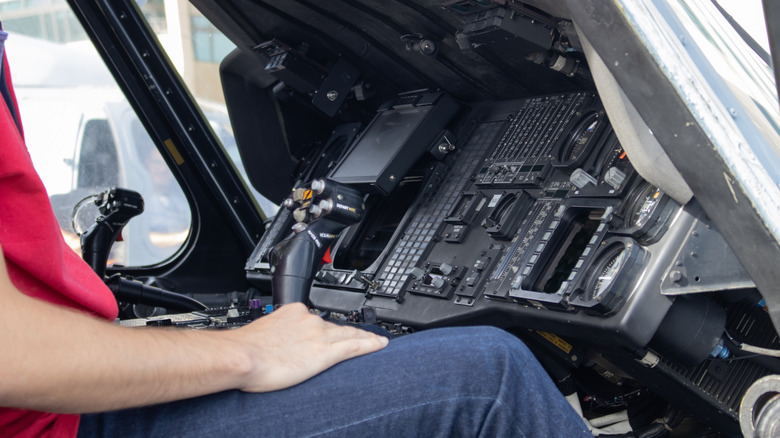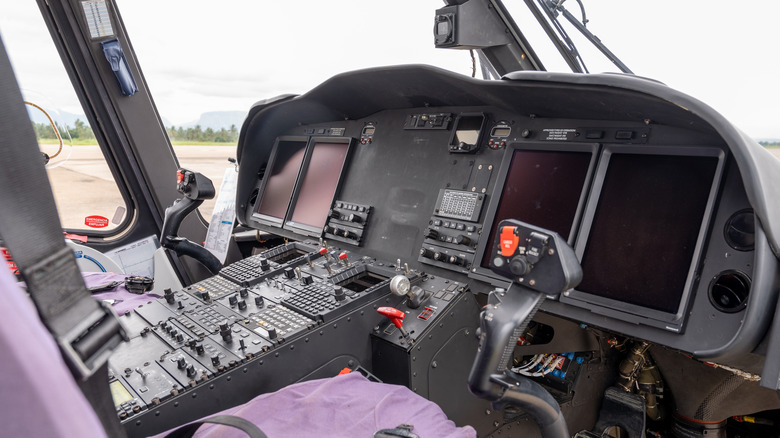Why Helicopters Have 2 Control Sticks (But Airplanes Only Have One)
Due to their hover and vertical takeoff and landing (VTOL) capabilities, helicopters possess distinct advantages over fixed-wing aircraft. Able to operate in tight spaces, isolated areas, and places, helicopters are best suited for specialized tasks, including disaster response and search and rescue, like the incredible firefighting helicopters. Compared to fixed-wing aircraft, helicopters are more difficult to fly because it is inherently unstable, requiring more intricate control systems that need frequent adjustments during flight. To maintain control of its many systems, some helicopters have two flight control sticks, while airplanes have one, which is enough to control their functions.
For helicopters that use two control sticks, each one has a distinct function. Starting with the collective stick, it adjusts and regulates the collective pitch of the main rotor blades, which affects the amount of lift produced and, essentially, governs the helicopter's vertical movement. Next is the cyclic stick, which is used to tilt the main rotor disk, which controls the helicopter's direction and speed. Motion on the cyclic stick is transmitted to the rotor disk, where it tilts to the input direction, producing thrust that moves the helicopter. An airplane, however, uses a single stick with fly-by-wire systems, where inputs are transmitted to the control surfaces via electronic impulses. Further to this, its rudder, which controls the yaw, is operated by pedals.
Additionally, certain larger helicopters like the renowned Sikorsky UH-60 Blackhawk are designed for two pilots, which necessitates two control sticks. Helicopters (and larger aircraft, too) that require two pilots are due to several reasons, including compliance with regulatory requirements, as a safety measure for redundancy in emergency scenarios, and to meet the increased operational and flying challenges that arise. Two pilots can help manage workload, improve situational awareness, and maintain safety in demanding or emergency situations.
Dual sticks for control and safety
With the advances in aeronautical technology, today's more sophisticated helicopters have moved from the traditional system of using separate collective and cyclic controls. Newer helicopter control systems now utilize Stability Augmentation Systems, which utilize sensors and advanced computers to help stabilize the aircraft, potentially eliminating the need for continuous control inputs. Next are the Automated Flight Control Systems, which automate certain functions, including maintaining a heading or altitude, thereby reducing the pilot's workload and reliance on manual control.
Examples of these modern control systems include the Skyryse system, which utilizes a combination of a fly-by-wire system and its SkyOS, providing the functionality of both the collective and cyclic controls in one stick. The single control enables the pilot to adjust the yaw by twisting, while a thumb lever at the top controls vertical movement; steering is done by moving the stick in different directions. Another one is Airbus Helicopters with its Human Machine Interface that allows the pilot and the aircraft's systems to communicate and exchange information, helping adjust flight parameters and monitor aircraft status.
For over 80 years, the unique capabilities of helicopters have impacted global travel and transportation due to their speed, versatility, and efficiency. Contemporary helicopters, including the evolutionary Bell Boeing V-22 Osprey, are slowly becoming more mainstream, and the key to their remarkable performance is the revolutionary technology and systems used for their dual flight controls. Soon, however, even more advanced systems will become available in helicopters, as artificial intelligence will be able to provide pilots with obstacle identification, flight path optimization, and even autonomous flight from AI-driven controls that can analyze real-time sensor data.

